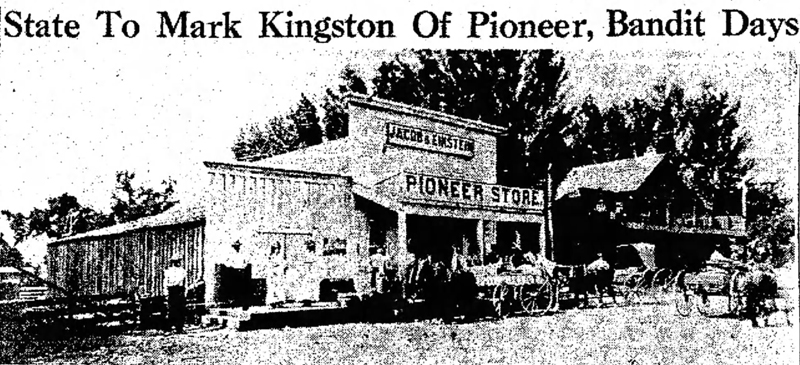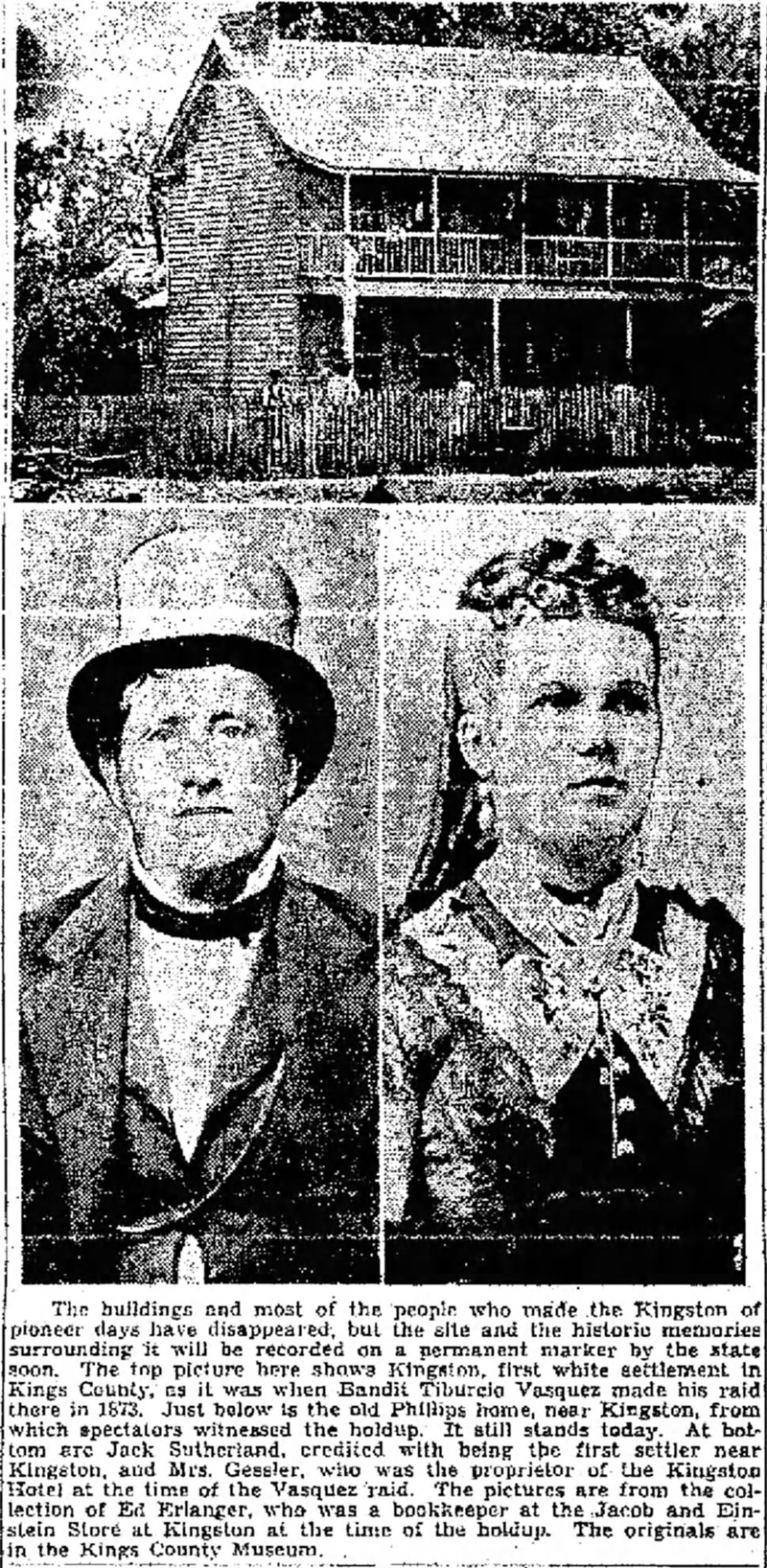|
|
Bandit Vasquez' Raid That Shocked Pioneers Recalled By Spectators.
By L.A. Fischer, Bee Staff Correspondent.
The Fresno Bee | Sunday, January 17, 1937.
|
HANFORD (Kings Co.), Jan. 16. — A permanent marker soon will be placed by the state department of natural resources on the site of Kingston, first white settlement in Kings County and scene of bandit Tiburcio Vasquez's sensational holdup of 1873. Only a few piers of the toll bridge of pioneer days and a rotted heap of what was once the Butterfield Stage depot remain today of the historic community, but pictures are extant showing it as it was in the early days. Practically all the early Kings County settlers of the '50s, '60s and '70s came through this little town on the Kings River and stopped for supplies or refreshments. It was the gateway to the Mussel Slough country and Mussel Slough meant to the settlers the land of promise. Kingston served as their first trading point, mailing point, school center and place of amusement. Famous Holdup Recalled In the minds of all the valley's early residents Kingston always will be connected with the famous holdup there by the notorious bandit Vasquez. This occurred on the day after Christmas, 1873. The toll bridge had nearly been completed except for the gates, and Vasquez utilized this opportunity to surprise the inhabitants and traders at Kingston. According to historians, Vasquez was accompanied by eight native Californians, two Americans and Negro. They left their horses on the north side of the river and crossed the bridge on foot. They immediately took possession of the whole town, appropriating a considerable amount of booty in money, jewelry and horses, and after giving battle to a posse who had collected under arms, made their escape. An account of the holdup is given by a witness of the gun battle, Mrs. E.D. Morton, eldest daughter of Perry C. Phillips, as follows: "The robbers entered the town at about dusk. They first encountered O.H. Bliss, operator of the ferry and the toll bridge. They compelled him to lie down or take a chance on being shot. They tied his hands and feet and searched him. When he complained that his head was in an uncomfortable position they jokingly brought him a blanket for a pillow. Victims Made To Lie Prone "Next they halted John Potts, Pres Bozeman and Milt Brown near the stable yard gate. The first two were made to like down and were searched, Bozeman yielding $180. Brown was marched to L. Reichert's hotel and lay down there. They placed a guard at each store, that of E. Jacobs and Louis Einstein and that of Sol Sweet. In the hotel saloon ten or more men were made to lie down and were searched. They lost about $100 and their watches. "In the hotel dining room a guest, Edward Douglas of Visalia, refused to lie down and was knocked down with a revolver. He, too, lost his money and watch. Lancelot Gilroy, a stage operator, was at supper when a bandit entered. Mrs. Reichert screamed and ran. Supposing the intruder had insulted her, Gilroy rose and floored the bandit with a chair, but he in turn was pounded down with a revolver. "At Jacobs and Einstein's store Edward Erlanger, the bookkeeper, ran to Sweet's store and gave the alarm. Sweet thrust his head out and was seized by a Vasquez guard and taken to the other store. Einstein was forced to open his safe and gave up $800. The bandits then took Sweet to his store and there obtained $54. "By that time a posse which had been organized at my father's house arrived. But one man in his excitement fired a shot, thus warning Vasquez and his men, who escaped. We women folks sat upstairs on the porch of the Phillips home and watched the shooting. One of the Vasquez gang was apparently wounded, and it was reported later that he died of his wounds. During the raid the gang had tied down thirty-nine men and taken away about $2,500."
Baby's Cry Annoyed Bandit Probably the youngest witness of the robbery was J.D. Bozeman, now of Hanford. "I guess I got the scare of my life all right," he said. "Only I don't seem to remember a thing about it. I was not yet a year old then. But the folks have told me often enough how I reacted. I am told that I took such a fright that I bawled all over the place. "Vasquez, annoyed by my outcry, ordered that someone shut my trap. It is said that a large, fat woman took me up and finally quieted me by acting as a wet nurse for me. To this day friends still taunt me by referring to this incident." Lie Murietta [sic; s/b Murrieta], Vasquez made liberal use of Cantua Canyon, a narrow defile in the mountains near the New Idria mines, north of Coalinga, as his retreat. Among his aides who accompanied him in his raids in Fresno and Monterey counties were Juan Soto and Red-Handed Dick. Vasquez was captured May 14th, 1874, near Los Angeles, and hanged at San Jose for shooting a [illegible; he was a hotelier] at a store robbery at Tres Pinos. Accounts say that he started his bandit career about 1856, two years after the fall of Murietta, but unlike Murietta, steered clear of bloodshed as much as possible. The Kingston holdup lent some prominence to the town for a while. As a business settlement it was doomed, however, by the rivalry of Grangeville and Hanford and the coming of the railroad. Another small town, Laton, grew up across the river from Kingston to take its place. The last remaining building, the old stage barn, tumbled to the earth about a year or so ago. Phillips Home Still Stands But a half mile to the east, the homestead of the pioneer Kingston family of Phillips still stands. The old place is occupied by R.H. Phillips, a younger son of Perry Phillips. American settlement in what is now Kings County began in 1854. Lands around Tulare Lake were occupied as early as 1820 by trappers, and were traversed as far back as 1773 by the Spanish Commandant Fages, who discovered the lake. But it was 1854 when L.A. Whitmore established a ferry across the Kings River, about a mile southwest of where the town of Laton now is. It was a natural trading point, and in two years sprang up a town, known first as Whitmore's Ferry, and afterward as Kingston, so named after the river. The site was once part of the old 40,000-acre Spanish land grant, the Laguna de Tache Rancho [sic; originally 48,801 acres]. Probably the first permanent American settler in the vicinity was Jack Sutherland, who came in 1855 and engaged in cattle ranching southwest of Kingston. Later he bought out Whitmore's Ferry which had previously fallen into the possession of O.H. Bliss, when Whitmore was killed. Kingston Was On Stage Line For years Kingston, or Whitmore's Ferry, was one of the principal stopping places in overland traffic between San Francisco and Los Angeles via the inland route. After 1858 it became a station on the Butterfield Stages line from Texas to San Francisco. It was also a Wells Fargo station. The hotel and postoffice did a thriving business. The ferry prospered but in time traffic became so heavy that a toll bridge was built in 1873. It was erected about a half mile west of the present Laton Bridge. The heavy use of irrigation today, reducing the flow of Kings River water, makes the thought of ferries somewhat difficult to conceive, but there are still many sons and daughters of the early settlers who tell fo the miles of flooded lands rendered impassable by the rampaging river. Among the early settlers of this vicinity, besides Whitmore and Sutherland, were John W. Bozeman, who came to California in 1854 and settled shortly afterward at Kingston; Daniel Rhoads, who came in 1856, and whose adobe built that year about thirteen miles southwest still stands; Jonathan Esrey, who came in 1857 by way of Kingston and settled some miles southwest; David Burris, who settled south of the river between Kingston and Kingsburg about 1857; Perry Phillips, who settled at the outskirts of Kingston in 1860, and whose frame house, erected in 1860, is still in existence. As late as 1879, Kingston had three stores, a hotel, livery stable, saloon, school, postoffice, stage depot, a doctor and — a race track. Memories of the old race track are still entertained by the old settlers. Among the spectators in the '70s was Mrs. Belle Runyon of Lemoore, a daughter of Perry Phillips. "Thousands of people came to the races," she commented, "and much money changed hands there. Boys used to train the horses for months, and sometimes went to school at Kingston while in training. "Nearby to the west was a Rancheria of about 300 Indians. It was an interesting sight to witness their fandangos, to which would come Indians from White's River and Tulare Lake to join in the fiesta." Mrs. Runyon said that as a child she would ride in the ferry to the school. Later the school was moved to the Kingston side of the river.
|
• L.A. Evening Express 12-29-1873 • Bakersfield Southern Californian 1-1-1874 
Raid Remembered 1-17-1937
|
The site owner makes no assertions as to ownership of any original copyrights to digitized images. However, these images are intended for Personal or Research use only. Any other kind of use, including but not limited to commercial or scholarly publication in any medium or format, public exhibition, or use online or in a web site, may be subject to additional restrictions including but not limited to the copyrights held by parties other than the site owner. USERS ARE SOLELY RESPONSIBLE for determining the existence of such rights and for obtaining any permissions and/or paying associated fees necessary for the proposed use.



